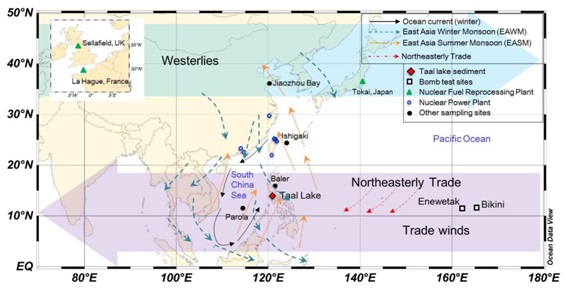
Human nuclear activities (HNA) never stop nor decrease in recent years, for example, construction of nuclear power plants and operation of nuclear fuel reprocessing facilities. Understanding the impact of these nuclear activities, therefore, is quite vital for environmental radioactivity and human health.
129I, the longest half-life iodine isotope, is a tracer to record nuclear activities. However, 129I records, at present, mainly focus on the middle and high latitudes of Northern Hemisphere, and only a few data can be found at low latitudes.
In collaboration with scientists from National Taiwan University and University of California, a research team led by Dr. HOU Xiaolin from the Institute of Earth Environment (IEE) of the Chinese Academy of Sciences recently presented a clear record of human nuclear activities at low latitudes by analyzing 129I and 127I in Taal Lake sediment core from Philippines.
Integrating variation of iodine isotopes in the core with human nuclear history, this study showed three distinct 129I depositional periods at low latitudes for the first time: a pre-nuclear period indicated by the lowest 129I/127I ratio, provided a baseline to evaluate the influence of HNAs;a period dominant with atmospheric nuclear weapons testing, mainly those at the Pacific Proving Ground, Marshall Islands, identified by first increase of 129I/127I ratios in early 1960s; a period controlled by discharge from nuclear fuel reprocessing plants with the feature of consistent fluctuations with gaseous releases and continuous increased with re-emission from seawater contaminated by liquid release.
Meteorological and model analysis indicated that the northeasterly trade and East Asian winter monsoon play significant roles for transportation of gaseous radioactive substance from the Pacific Proving Ground during the second period and from nuclear fuel reprocessing facilities during the third period.
The study extended 129I records from high-middle to low latitudes and from marine to terrestrial environment, showed the quantative impact of HNAs for the first time, and pointed out the sources and transport pathways of radioactive materials in modern environment of Southeast Asia.
It was also of great significance for studying dispersion of other volatile gaseous pollutants due to the advantages of 129I. Besides, the study firstly suggested that iodine isotopes could be used as a tracer for volcanic eruptions.
Their work was published in Chemosphere.

Fig.1 Geographic location of Lake Taal (Philippines), source of nuclear activities and transportation pathways. (Image by ZHANG et.al)

Fig.2 Concentrations of 127I and 129I, and 129I/127I atomic ratio in the sediment. (Image by ZHANG et.al)

86-10-68597521 (day)
86-10-68597289 (night)

86-10-68511095 (day)
86-10-68512458 (night)

cas_en@cas.cn

52 Sanlihe Rd., Xicheng District,
Beijing, China (100864)

